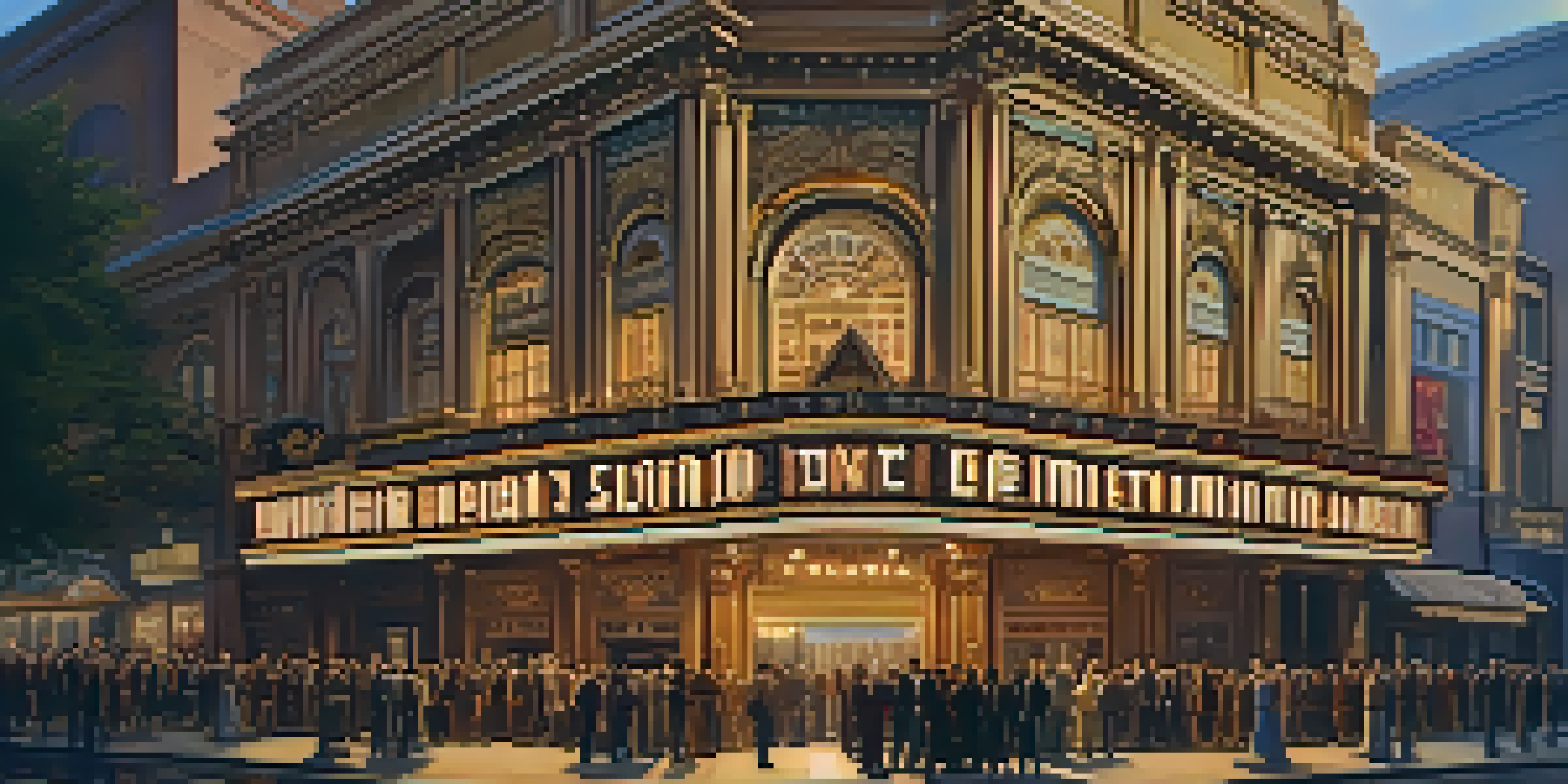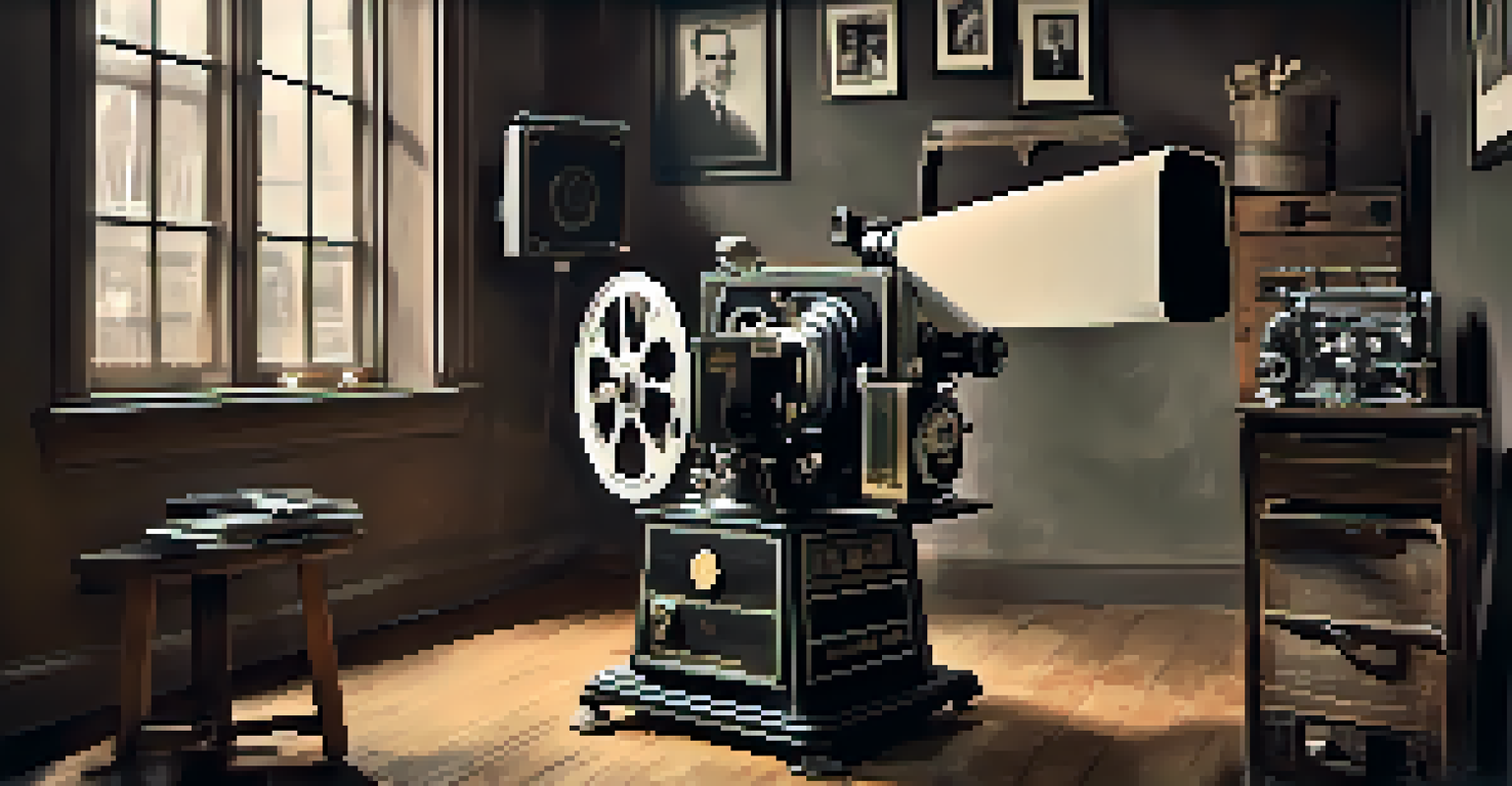The Silent Era: Beginnings of Film Censorship in Hollywood

The Birth of Cinema: A New Frontier in Storytelling
The advent of cinema in the late 19th century opened a new world of storytelling. Silent films captivated audiences with their visual narratives, transcending language barriers. This revolutionary medium quickly gained popularity, but with it came the need for oversight as societal values were often reflected on screen.
The most effective way to destroy people is to deny and obliterate their own understanding of their history.
As filmmakers pushed creative boundaries, the portrayal of sensitive themes sparked debates about morality. With stories ranging from romance to crime, filmmakers often found themselves navigating a complex landscape of public opinion and ethics. Thus began the conversation about the necessity of censorship.
Censorship emerged not just as a means of control, but as a reflection of societal standards. As films drew larger audiences, the question arose: what content was acceptable? This dilemma laid the groundwork for the evolving relationship between filmmakers, audiences, and governing bodies.
Cultural Context: The Impact of Social Norms
The silent film era coincided with a time of significant social change in America. The changing roles of women, the rise of urban culture, and the impact of immigration shaped public sentiment. These factors influenced what was deemed acceptable in film and created a backdrop for censorship discussions.

As films began to depict more daring subject matter, such as crime and sexuality, conservative groups emerged to voice their concerns. They argued that films could corrupt morals and lead to societal decay. This tension between artistic freedom and societal values was palpable, prompting calls for regulation.
Censorship Shaped Early Cinema
The rise of censorship in the silent film era reflected societal values and sparked ongoing debates about moral standards in storytelling.
Censorship during this period was often a reflection of prevailing attitudes toward gender, race, and class. The desire to protect audiences, especially children, from perceived moral threats led to the establishment of guidelines and standards that would shape the industry.
The First Censorship Boards: Establishing Guidelines
In response to growing concerns, cities and states began forming censorship boards to review films. The first of these, the Chicago Board of Censorship, was established in 1907, marking a significant shift in the film industry. These boards held the power to approve or ban films, setting a precedent for future regulations.
Censorship is the child of fear and the father of ignorance.
The boards often focused on content that was considered offensive or inappropriate. This included depictions of violence, sexual content, and anything that challenged social norms. Filmmakers were forced to navigate these restrictions, which sometimes led to creative compromises.
While censorship was intended to protect audiences, it also sparked controversy and debate among filmmakers and critics. Many argued that such restrictions stifled creativity and limited the potential of cinema as an art form, igniting a dialogue about the balance between regulation and artistic expression.
The Role of the Hays Code: A Turning Point
The Hays Code, officially known as the Motion Picture Production Code, was introduced in 1930 as a more comprehensive set of guidelines for filmmakers. This code aimed to standardize moral content across the industry and was a direct response to the chaotic landscape of censorship. It outlined specific dos and don'ts, offering filmmakers a clearer understanding of what was permissible.
Under the Hays Code, films had to adhere to strict moral standards, affecting everything from plotlines to character development. This included banning depictions of explicit violence and sexual situations, which significantly altered how stories were told. The code enforced a certain moral compass, shaping the narrative style of the era.
Censorship Shaped Early Filmmaking
The rise of censorship during the silent film era influenced filmmakers to navigate complex societal norms and moral standards.
Though the Hays Code faced criticism, it also led to innovation within the industry. Filmmakers learned to communicate complex ideas through subtext and symbolism, ultimately enriching the storytelling process. This period marked a transition, as censorship evolved from reactive measures to proactive regulations.
Public Outcry: The Backlash Against Censorship
As the Hays Code took hold, public outcry against censorship began to rise. Many filmmakers and critics argued that the restrictions limited artistic freedom and stifled creativity. This backlash highlighted the tension between the desire for moral protection and the need for creative expression in film.
Advocates for change emphasized that censorship did not necessarily protect audiences; instead, it often misrepresented reality and suppressed important social issues. They argued that films should reflect the complexities of life, including its darker aspects. This push for more authentic storytelling sparked a debate that would continue for decades.
The backlash against censorship also highlighted the evolving attitudes towards morality in film. Audiences began to seek out films that challenged societal norms, leading to a gradual shift in how content was perceived. This movement laid the groundwork for future changes in film regulations and censorship practices.
Legacy of Silent Era Censorship in Modern Film
The silent era's approach to censorship has left a lasting impact on the film industry today. While some regulations have relaxed, the debates surrounding content and morality continue to resonate. Filmmakers still grapple with how to balance creative expression with audience expectations and societal values.
Modern audiences are more diverse, leading to a broader spectrum of themes and stories in film. This shift challenges traditional notions of censorship, prompting filmmakers to explore previously taboo subjects. The legacy of the silent era reminds us of the ongoing evolution of societal norms and artistic boundaries.
Hays Code Created Strict Guidelines
The introduction of the Hays Code established comprehensive moral guidelines that significantly altered storytelling in cinema.
As we reflect on the silent era, it's clear that censorship is not merely about restriction; it's about dialogue. The conversations sparked by early censorship practices continue to shape the landscape of cinema, emphasizing the importance of storytelling in reflecting the human experience.
Conclusion: The Evolving Landscape of Film Censorship
The silent era marked a pivotal moment in the history of film censorship, laying the groundwork for discussions that persist today. As filmmakers navigated the complexities of societal expectations, they forged a path that continues to influence the industry. The balance between creative freedom and moral responsibility remains a nuanced conversation.
Censorship in Hollywood has evolved, reflecting changes in cultural values and audience expectations. However, the lessons learned during the silent era remind us of the importance of dialogue and understanding in navigating the intersection of art and ethics. This ongoing evolution ensures that film remains a powerful medium for storytelling.

Ultimately, the legacy of the silent era serves as a reminder of the profound impact that film can have on society. As we move forward, it is crucial to honor the past while embracing the future, allowing filmmakers to tell their stories authentically and responsibly.